
They can be quite fat. This one is 6 cm thick and weighs 3 Kg, 6.8 lb. Note all the foldout pages.
20231103 TerraHertz http://everist.org NobLog home
It's now nearing the close of 2023, and the last time I wrote anything here in my NoBlog was the Feb 2020 article about restoring an old valve oscilloscope. Then nearly three years silence.
This article is not about why that gap happened. But here's a brief explanation:
Then through 2021 there was the worst of Covid-19, lockdowns, and the sorrow of learning that most people are far more gullible, easily coerced and scientifically ignorant than I could have believed without seeing it, plus our governments are even more vile and hostile than I'd already known.
2022 continued the pattern, with my aged mother's rapid health decline, hospitalization, and admission to a nursing home (all during Covid.) The work of clearing out her home by myself (an only child) and arranging the sale, her passing just before the auction (resulting in an awkward legal situation - but resolved), handling the probate and estate, and sorting out her posessions (then stored at my house.) The sorting of stuff and reassigning of space in my house as I work out what I want to keep and do, is still ongoing in 2023.

They can be quite fat. This one is 6 cm thick and weighs 3 Kg, 6.8 lb. Note all the foldout pages.
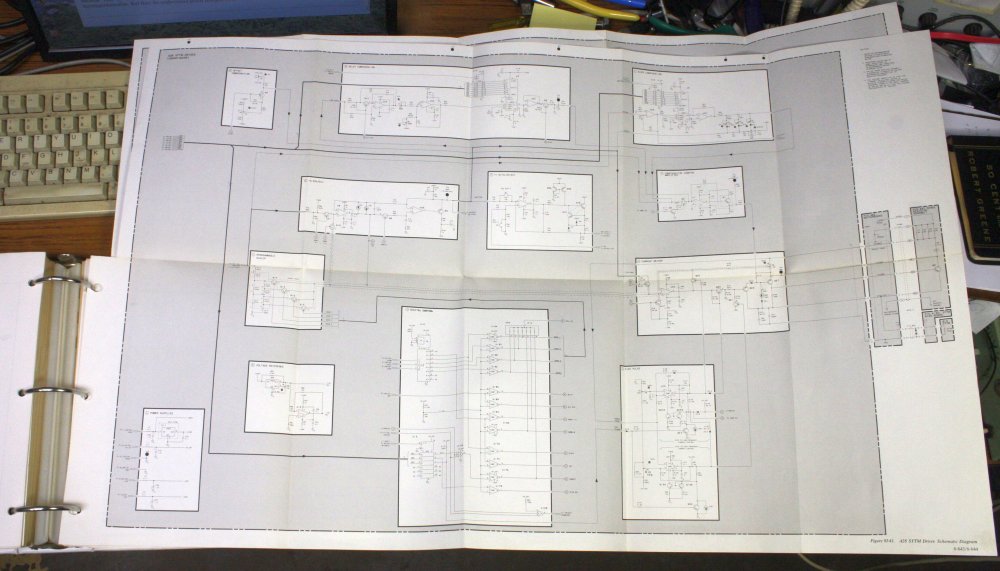
Those typically fold out to sheets much larger than the manual size. Some fold out horizontally only, some fold out both horizontally and vertically. There are usually many foldouts, with very fine printed line detail, sometimes with multiple colours and/or greyscale images. Of course the same level of detail will be found on many of the non-folding plain pages too.

A small part of one such foldout, to show the typical fine detail. This photo barely resolves it.
Incidentally, spot the magic crystal. No really! Well, except it's physics not magic.

Of no significance to this tale, here's the cover of this particular manual. Now you know what the thing this manual is for, looks like. At least the front panel.
There's the manual's spine too. Notice anything? Yeah, this big fat manual is Volume 4 of the complete service manual set. Volumes 1, 2 and 3 are equally fat. That's in addition to the Operating manual, and in many cases a few others such as Programming.
This manual was printed in 1984. Current ebay prices are up to US $200 for one volume. The catalog price of the HP 8340A in 1985 was US$69,100. Now they are around $2K to $5K on ebay, so individuals can afford them.
As always it's completely impossible to maintain, repair and calibrate such equipment without these manuals. There never were many more manuals than the number of machines made, and sometimes not even that many. Now such manuals are no longer made at all.
The number of manuals surviving has dwindled rapidly over the years, for multiple reasons. Initially most were owned by corporations, and they rarely care about preservation. When the equipment is superceded they often just throw out the equipment, and the associated manuals.
There are several other causes of destruction, including a more recent one that has become dominant and is still growing.
I've written about this situation before, see Golden, and really much of that entire article was about the difficulty of finding necessary service manuals and why they are increasingly rare.
To recap: up till about the late 1980s, most companies making high end electronic test gear were run by Real Engineers, who felt their purpose in life was to make products for the advancement of Mankind and Civilization. Hence obviously customers had a right to excellent highly detailed Service Manuals so they could maintain the equipment themselves. And so, excellent highly detailed manuals were produced.
Nowadays this is called 'right to repair' and most corporations think their customers don't have any such right.
What happened was, all the Real Engineers grew old and retired. After which the companies they'd built up became run by MBAs and lawyers. Generally types for whom the phrase 'betterment of Mankind' is incomprehensible. But they do understand profit margin, so no more service manuals! Virtually no current electronics of any complexity, has useful service information made available to buyers.
Additionally the surviving old paper service manuals are being destroyed at a high rate. Partly due to the modern 'mass formation psychosis' (widely held irrational belief) that paper books are a pointless waste of space, 'because they are all available in digital form online.'
Well, they're not. Many do exist, scanned to PDF format. Problem #1 is that PDF has no internal non-lossy image compression format. It's basically JPG or the B&W 'FAX-modes', or nothing. There's no PNG inside PDF. So you can have your page images with blurry JPG artefacting, or jaggy B&W two-tone pixelation. Both fail to varying degrees for fine detail and tonal images. Not even delving into other issues such as screen printed image moire patterns, the tragic joke of JBIG2 format, and so on. Fundamentally PDF is a pathetic standard for representing scanned documents. Acceptable only to people who have little visual discernment, and zero comprehension of the importance of conserving historical documents in their full original visual resolution and quality. However another thing this article is not going to be about, is the flaws of PDF and how they came to be.
Problem #2, is the numbers of people who are aware that these old manuals are becoming rare, and many are still not online in any form at all. So their first thought is to scan every old technical manual they can get their hands on. Except they don't have the knowledge, skills, equipment or patience to do an adequate job of the scanning. Of course they scan to PDF, with all its inherent flaws - because they know no better. In any case their efforts are generally digital crap.
And then... and then... they say to themselves "Ah, I have scanned it and put it online! Yay me! Now I can throw out this old paper waste of space." (ie the original document.) Which they do. If they didn't already destroy it in the scanning process by cutting spines off, etc for auto-feed scanning. Even the big, well known digital archives do this. Also many great public libraries convert their collections to digital... and dispose of the originals, 'to save storage costs' and so on.
I call them the 'scan and destroy horde.' They remind me of Daleks.
We are living in a new Dark Age, from which little knowledge will survive. We're trashing the paper records, and yet we have NO digital storage physical media that is truly long lived and can survive even 100 years of neglect. Unlike paper that can survive hundreds of years just sitting there, if kept in reasonably paper-friendly conditions. (If it wasn't 'acid paper' but that's a separate disaster.) And btw, the belief that 'the cloud' is a reliable long term storage anything, is another instance of mass formation psychosis.
As for me, I'm a fan of keeping paper originals. For one thing, one can be sure no one ever editied/sanitized/censored/altered the contents since the document was printed. Ink on paper, it's pretty hard to mess with that. Also the documents are history embodied. They retain the full art and skill of the publishing process — something digital copies simply do not. Not with current document representation file formats anyway. There are techniques used in printed technical documents that present severe barriers to accurate capture by present scanning and file representation methods. For instance gray scale images with ink 'screened' patterning, that then had hard-edged lines and text characters overlaid on the screening dot pattern before the final plates were rolled on the presses.
It's my view that scanning hardware and software simply isn't anywhere near good enough yet. Perhaps it may become so in future, but till then we absolutely have to keep original copies of everything that should be preserved for posterity. Indefinitely, just to be sure.
But it doesn't seem like anyone is doing that. No one just stubbornly keeping paper originals, for the future, because History.
Sigh. Alright then, I'll do it myself. 'Save ALL the manuals' — ha ha I wish. But unfortunately, no Infinity Stones.
I had always tried to acquire original manuals for equipment I own. In recent years with these manuals rapidly becoming rarer, I started buying available manuals 'just because' — maybe I'd get the matched equipment later? Or simply because I thought some manual was cool. I was starting to build a fair sized collection. Still insignificant really, but pleasing.
10x15 Storage unit Test Equipment Manuals, several thousand. Keysight Agilent Condition: Used Item: 284495450498 Price: US $99.00 Shipping: Free Local Pickup. Located in: Roseville, California, United States Seller: who-is-on-1st (2296 ) Entire lot of 10x15 storage unit of Test Equipment Manuals. There are thousands in this unit. (There's a few personal items I need to remove). You'll need a large truck to pick these up. In the back are over 50 boxes already packed. Winning bid needs to remove within 2-weeks of award. Please ask any questions. Keysight / Agilent / HP / Tektronix / Anritsu / Fluke / Advantest / TTC / Wiltron / Wavetek / R&S (Rohde & Schwarz) / Systron Donner / Scientific Atlanta / ESI / Boonton / Gigatronics / IFR / Keithley / Stanford Research
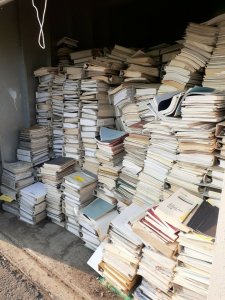 |
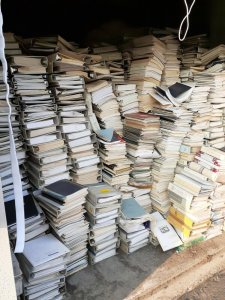 |
 |
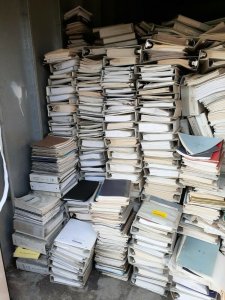 |
 |
Good heavens! That goes back 15', all stacked? It's certainly a LOT of manuals. I wish I could buy them, but they are in USA, and I'm in Australia. Also the seller needs them removed within two weeks. How many kinds of impossible at once is that?
Hmm... It should be feasible to get a moving company to ship them (container, by sea?), though it could take a while to set up. I could afford it...
I sent the seller a quick message, asking if there was any possibility of extending the deadline.
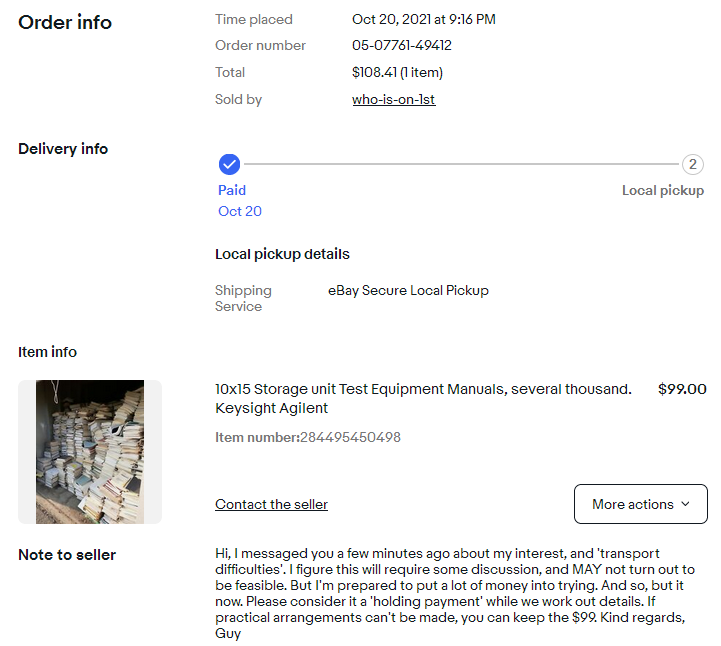 And then while further considering the asking price, realised it's probably so low because he knows the magnitude of this task will put most people off. But he needs them gone. Meanwhile if someone does want the manuals and is prepared to move them, then $99 is a great incentive to snap them up immediately.
And then while further considering the asking price, realised it's probably so low because he knows the magnitude of this task will put most people off. But he needs them gone. Meanwhile if someone does want the manuals and is prepared to move them, then $99 is a great incentive to snap them up immediately.
Uh... wait a minute. 'Does want them and is prepared to move them'? That's me!
$99 is low enough that it could be considered just a token, to secure the manuals while investigating shipping options. Low enough to just write off if things don't work out...
I could buy them right now, work out logistics later. Meanwhile anybody else could be thinking this too. This 'item' could sell to someone else at any moment. Why am I dithering?
So quite briefly after sending my first inquiry, I did a 'buy it now', paid, then immediately sent the seller a new message. →
(Typing in hurry typo: "but" should be "buy".)
 Contemplating this ebay screen induced a mix of emotions. Technically, I now own this huge mound of manuals. In the USA. My 'manuals collection hobby' just entered a whole new realm. One involving all kinds of potential challenges and expenses. Definitely going to be a lot of work and stress. Some kind of 'library extension' on my house. Learning about and paying for 'Serious Shipping'. Wondering how much money I could theoretically have saved, by just never buying any manuals up to this point, because there are probably duplicates of most of them in that mound. Oh well...
Contemplating this ebay screen induced a mix of emotions. Technically, I now own this huge mound of manuals. In the USA. My 'manuals collection hobby' just entered a whole new realm. One involving all kinds of potential challenges and expenses. Definitely going to be a lot of work and stress. Some kind of 'library extension' on my house. Learning about and paying for 'Serious Shipping'. Wondering how much money I could theoretically have saved, by just never buying any manuals up to this point, because there are probably duplicates of most of them in that mound. Oh well...
On the plus side... Adventure! This is going to be a fun challenge. I hope it works out.
The seller responded quickly. He's a pleasant, articulate and entirely reasonable fellow. That was a huge relief, after an experience I'd had some months before in Aug 2021. I'd bought a small shelf full of manuals, from an ebay seller who turned out to be nearly impossible to communicate with, and not entirely honest. That had eventually resolved, but it was a pain.
We switched to email, to escape the 'tiny ebay text box' shackles. As you've probably deduced, from that point it took two years to get this done. But the obstacles were all external. Logistical, bureaucratic and 'Force majeure' kinds of things. Throughout it all the seller (we'll call him 'T') was invariably patient, kind and helpful. Thanks T!
Now writing this in late 2023, there's the problem of conveying two years of correspondence with T. A core element of this story. However yesterday I compiled them all to a single sequential file, which took several hours and the file is nearly 200 KB of plain text. It's TOO MUCH detail! Also I don't have a right to just post T's emails.
So summaries it is then.
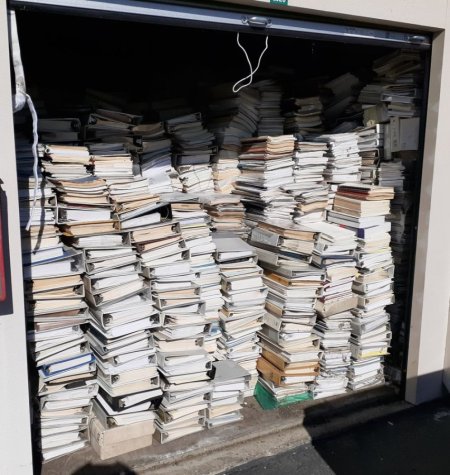 ← More manuals were added later, this is the final quantity.
← More manuals were added later, this is the final quantity.
Due to other urgent issues, I'm not getting time to finish this article. In the meantime here's the final result (so far.) The container full of manuals sitting in my carport. Yes I can still park my car there.
